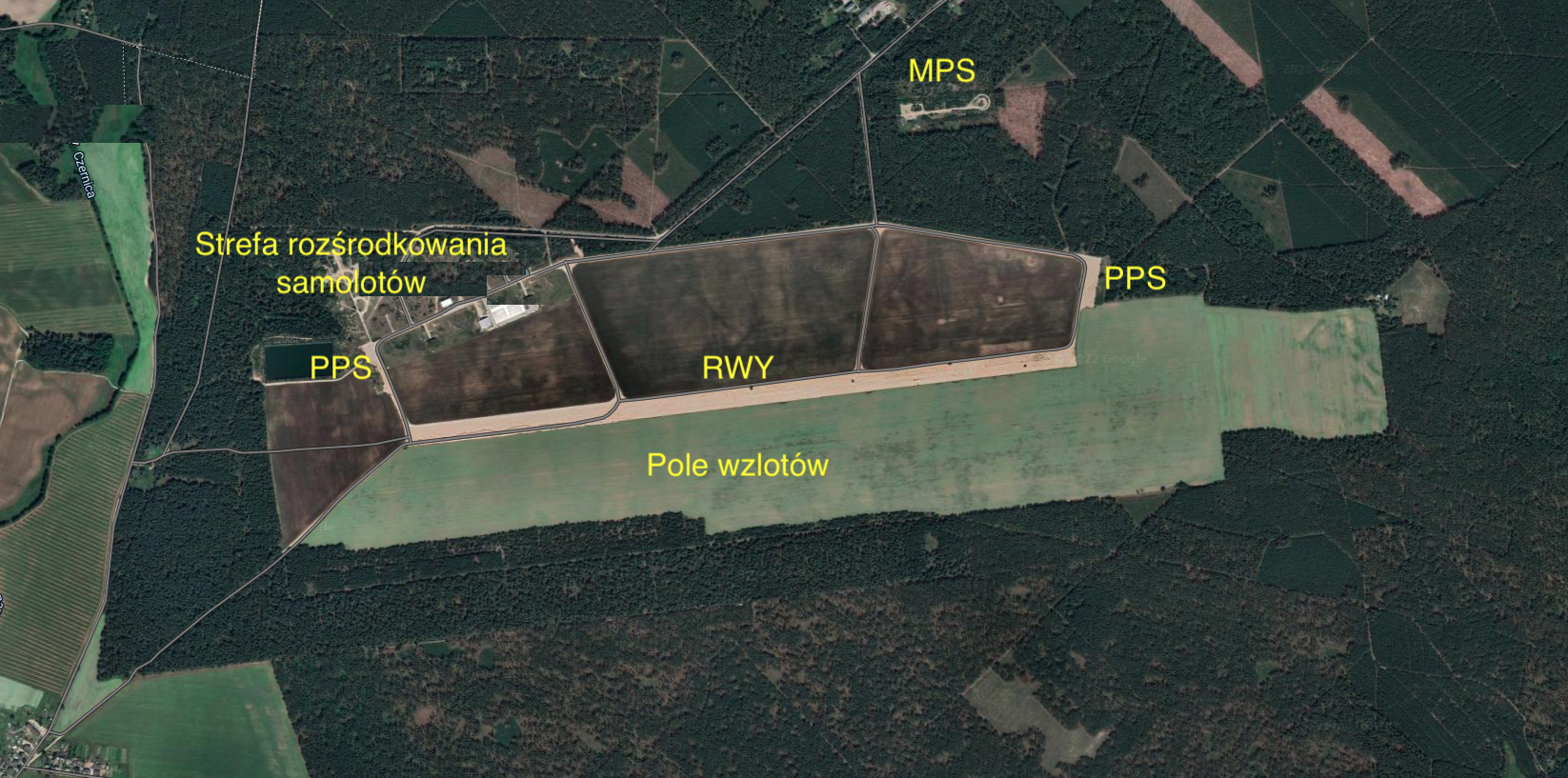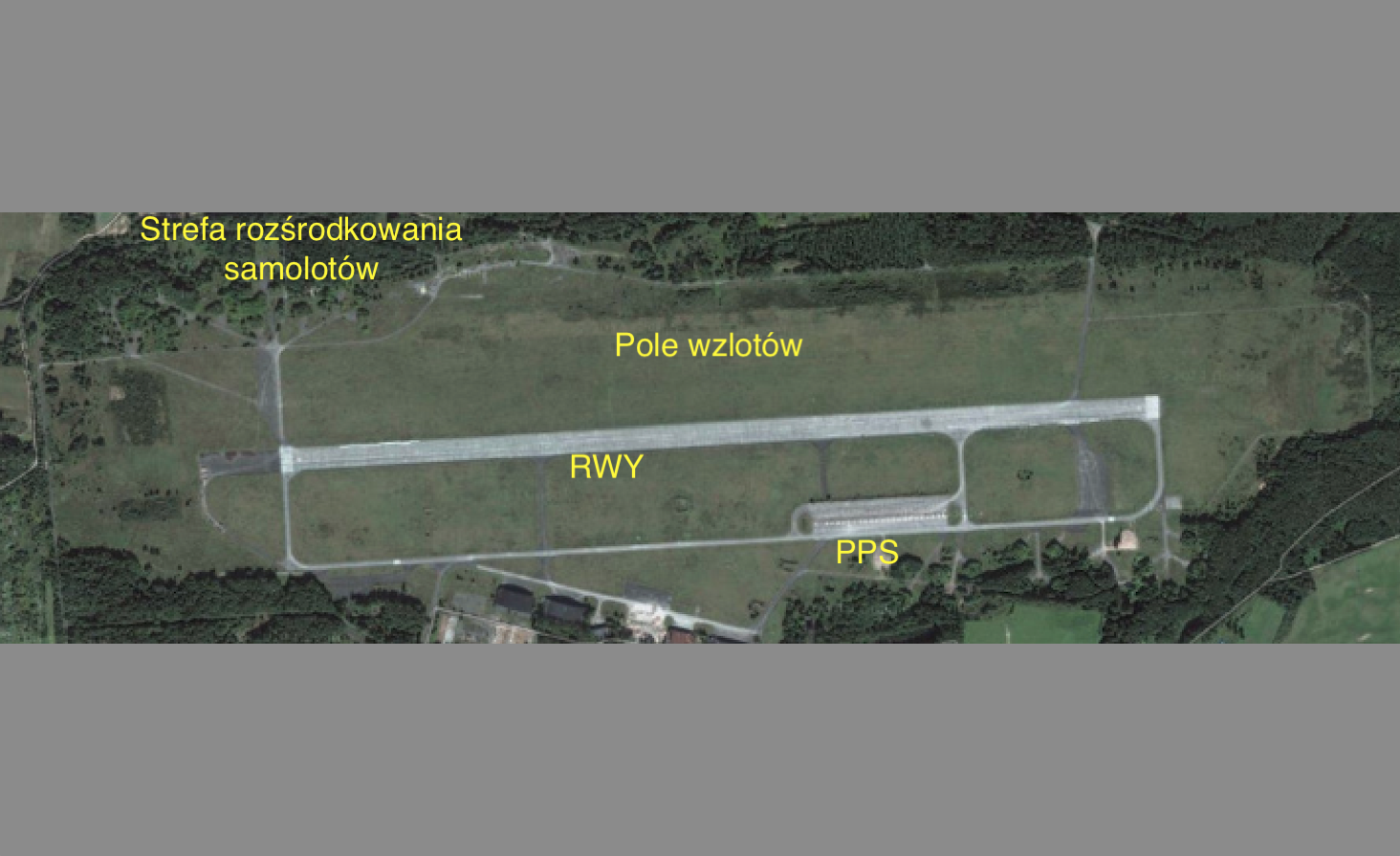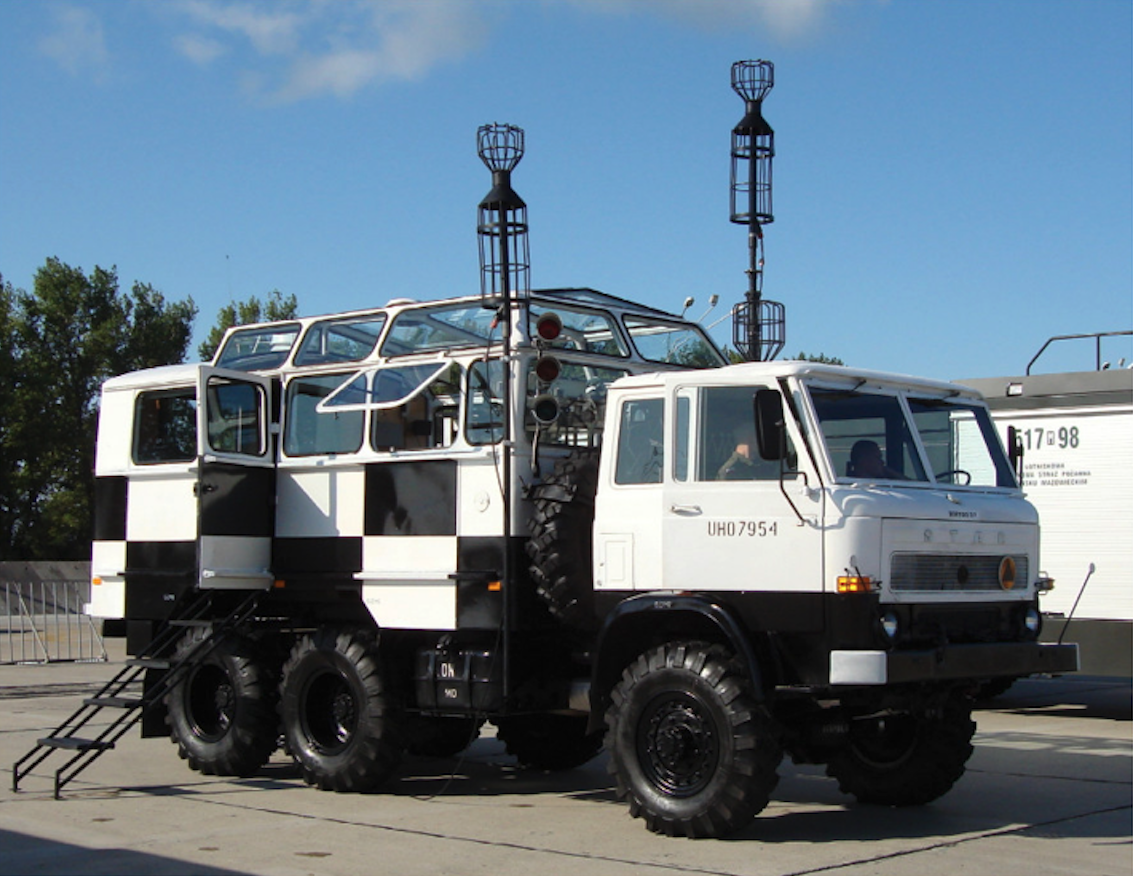Kraków 2014-12-12
The landing area and the flight control station in the 70s of the twentieth century.
The landing field of the Military Airport.
In the 1970s, almost all airports in Poland were military airports. Except for Okęcie Airport. The Okęcie airport was specific and consisted of a civilian and a military part, and was the only one in Poland with the status of an international airport. The second exception was the Rębiechowo-Gdańsk Airport opened in 1974, which was and is only a civil-commercial airport. And the third exception was the Jasionka-Rzeszów Airport, which existed as a civilian and school airport, and was not occupied by the army only because it was located very far from the north-western borders of Poland. Non-military airports include airports operated by flying clubs and factory airports.
The others were military airports, sometimes adapted to the traffic of PLL LOT aircraft and the transport of passengers and goods. This was the case in Goleniów, Słupsk, Zegrze Pomorskie-Koszalin, Strachowice-Wrocław, Balice-Kraków, Ławica-Poznań. The vast majority of these airports were built in the 1950s, according to plans received from the CCCP. That is why the landing fields of almost all military airports in Poland were similar.
The standard landing field of an air regiment had an area of \u200b\u200babout 150 hectares. It had a shape similar to a rectangle, about 3,000 m long and about 500 m wide. Usually surrounded by natural forests or artificial trees. Typical take-off fields had a runway (DS, RWY) with a paved surface; concrete or asphalt concrete. Often placed in the direction of the most frequent winds blowing in Poland, i.e. east-west. The dimensions of the RWY are usually 2,400 m x 60 m. These dimensions allowed for the operation of all aircraft used in Poland; fast (MiG-21, MiG-23, Su-7, Su-20), heavy (An-12, An-26).


In the photo above, the runway (RWY) with dimensions of 2,400 m x 60 m is clearly visible. Concrete pavement. Both RWY thresholds painted in white stripes (keyboard) that indicate the width of the runway, similar to the current one. There are no currently painted two large rectangles that are crosshairs. There is also no broken center line. Instead, there are three or four dashed axial lines. It was related to the parallel, simultaneous start of up to four MiG-21 fighters.
This is how runways at military airports in Poland were painted in the 70/80s. A keyboard with an odd number of keys. There are 9 of them. They measure approximately 2.5 m x 15 m. There is no central line. The touchdown zone painted on the left side. It is represented by 6 rectangles, of which the inner ones are about 15 m long, and the outer ones are about 10 m long. You can also see the central line for taxiing airplanes.
By the way, the presented runway is one of the largest in Poland. Length 3,287 m x 60 m. Biała Podlaska Airport, 2006. If there were right-wing governments in the Republic of Poland (around 2010), at least one squadron of F-16 Jastrząb aircraft would be stationed at this airport. And so we have another ruin and not far away, unpredictable comrade-Tsar Vladimir Putin. At military airports, an emergency runway with a dirt surface was always marked out. The emergency runway was always located parallel to the main runway.
There were no special devices or systems on the take-off area to catch the aircraft that taxied outside the RWY. When the basic aircraft in the Polish Army were the PZL Lim-2/5 aircraft, more often the machines rolled out to the side of the runway axis. These were usually harmless events. There were damages to the undercarriage, suspended fuel tanks or lamps of the side strip lights. When the MiG-21 aircraft, popularly known as fast, were introduced into service, there were extensions beyond the thresholds of the RWY. Sometimes very far, which ended at the fence of the airport. Therefore, at a distance of about 200 m from the threshold, part of the area was plowed and harrowed. In this way, a soft ground was created in which the landing gear got stuck and effectively braked the aircraft. Such an area was popularly called a migołpak. A simple and effective method. In the USA, a much more expensive method of catching planes has been developed. It is based on a material made of concrete and pumice. Such a surface easily supports a person, but the plane sinks in it.
This does not mean, however, that work on professional aircraft catchers was not carried out in Poland. Aircraft catchers were introduced at several airports in the late 1980s.
Flight Control Station.
The flight control post, abbreviated as KL, was sometimes called the Launch Command Post (SSD). The flight control post (KL) was the point where a group of soldiers, using communication, radar and light equipment, managed flights, and above all, take-offs and landings of airplanes and helicopters. At the head of this group was always the Flight Director, who had the appropriate knowledge and experience. Because military aviation was very mobile, it could conduct flights even in places where there was no extensive infrastructure. Where there was only a runway suitable for the aircraft, with a runway with a suitable surface.
It is worth noting that in the 1970s, take-offs and landings on DOL were often carried out without the use of radar equipment. In the 1940s, the ATC station practically consisted of a table placed on the landing field and a radio station placed on it to communicate with the aircraft crews. There was also a flight plan, a list of pilots and planes, their codenames, etc. There was also a radio station at the disposal, working all the time listening on the backup (emergency) frequency, to receive information about unexpected problems of any of the crews and their plane at any time. A tent was set up near the KL station to improve the general working conditions of the team. Spare batteries for communication radios and spare radio stations were kept in it. You could eat a meal there, quench your thirst or hide from the rain. There was also a wired field telephone, thanks to which it was possible to receive orders from the commander of the unit and submit reports. Usually it was the TAJ-43 phone, and in the 60's the newer TAP-67 appeared. In addition, the KL station had a company bicycle, motorcycle or GAZ car (popularly known as Gazik).
At the end of the 40s, the KL station began to be organized on trucks, which greatly facilitated its development and, above all, shortened the time needed. Ambulance cars with a doctor and paramedics began to be on duty at the KL post. Fire trucks were also on duty, with crews ready to act at any time.
With the mass introduction of turbojet-powered aircraft into service, the process of modernizing the ATC station began. In Poland, it was unique because, as the only one in the eastern kolkhoz, we started to develop and build fully mobile KL stations, which materialized in the form of cars or trailers called krasuls. The name krasul came from the black and white chessboard in which the vehicle was painted. They were the only military vehicles not painted dark green. Even the military fire trucks were painted dark green. An exception were also vehicles of the Polish Army taking part in foreign peacekeeping missions, which were painted white. The first Krasules were assembled on the basis of Lublin-51 (GAZ-51) car chassis. Krasul's equipment changed with the introduction of a new technique to the armament. These were newer communication radios, telephones and telephone switchboards, and others (binoculars, night vision goggles, light and alarm systems).


The antennas of the communication radio station were set up near the car, lifted to a height of 8-10 m, and stabilized with guy wires. The car often had a trailer with a power generator. There were 4 soldiers in the car. In more complicated tasks, the karst cast increased to six soldiers.
The following positions were held in Krasula: Flight Director - an officer who decided almost everything. Allowed take-offs and landings. Commencement or interruption of a task performed by the flight crews. He conducted radio correspondence. He had telephone communication with the regimental commander. The flight director was the squadron commander or the regiment commander himself. Officer from the Flight Insurance Battalion (Flight Command Squadron) - an officer who supervised the preparation of planes or helicopters for flight and reconstruction of their combat capability; refueling, loading weapons and others. He had information about the time a given aircraft was in the air. Meteorologist - An officer who constantly monitored weather conditions. He collected information provided by the crews about; cloud cover (given in decimal degrees), cloud base (in meters), precipitation, haze, fronts, wind direction. Planchkeeper - a soldier who presented the current (on-line) location of planes (single, pair or flight) in the air on maps or a planchette, i.e. the tactical situation.
Written by Karol Placha Hetman
